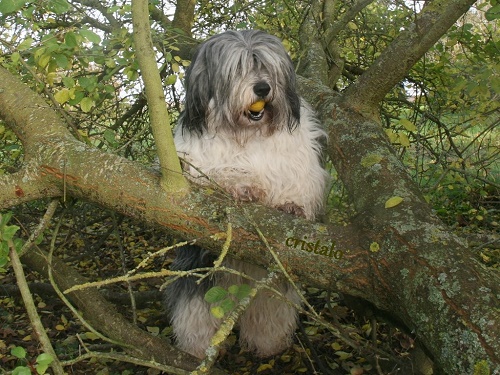Your PON loves your
Christmas tree or other holiday decorations. However,
there are risks of poisoning, choking,etc. if he gets
hold of these decorations when you are out of the area.
You can avoid tragedy by teaching your PON specific
perimeters in this situation and other situations during
the year.
You
need to make basic decisions as follows:
-
What is the
exact location for your PON that is
off-limits? You may decide to put a rope around the
tree and teach him not to put any part of his body
over this line.
- C
rates,
baby gates or leaving your PON in another room when
you are not home or watching him may help start the
process of teaching your PON to avoid tragedy.
- Decide on
the timeout area that you will use during this
training.
-
Now you
are ready to begin. To teach consistency, your PON
must never touch the tree when you are not watching
him, or he will learn that it is safe to do so when
you are not there. To train any behavior the most
quickly, the closer you can come to a 100% success
rate the better. If he is allowed to chew on the
tree or lie under the tree, it will be more
difficult to change the rules later. Start
consistent, stay consistent!
To practice
training sessions accomplish the following:
-
Put your
PON on a leash
-
Walk him
near the tree
- Offer him a
treat and everything appropriate, including walking
by the tree, looking at the tree, sitting, lying
down, etc.
-
If he
takes ONE step over the defined line say, “fui! fui!”
and gently guide him away from that location, and
immediately praise him when his body is in a proper
location away from the tree.
-
Continue
practicing and make it more enticing for him to go
near the tree, including throwing toys or treats in
underneath it. Often when you want to work training,
your PON behaves differently because you are
watching him. Sometimes you have to entice him to
make a decision while you are there and gently teach
him it is not appropriate.
-
The second
time he puts a paw over the line, gently guide him
away and then give him praise.
-
The third
time he puts a paw over the line, say, “Timeout” and
gently move him to the timeout location.
-
Wait 10-30
seconds and remove him, only if he is quiet, and
repeat.
-
Once he is
timed out one time, the next time he crosses the
line it is an instant timeout.
-
Continue
until you can tell that he is thinking, “It sure
doesn’t pay when I go near that tree!”
If you feel
frustrated, focus on appropriate behavior. Start by
giving feedback at least every 6 seconds including
verbal feedback, petting, treats, and toys when he is
behaving correctly. Keep him far away at the beginning
and reward him for anything that is correct. Even if he
is 15 feet away from the treat on leash, he should be
rewarded, because that is one of the many possibilities
that you want him to do in the future. If tomorrow he
chooses to stay 15 feet away from the tree, that is
great!
As you do more training,
use more verbal feedback and less treats. Long-term, a
big part of the reward is "staying with the party" and
not getting timed out.
Timeouts can
be very sensitive The concept behind timeouts involves
teaching your PON that one behavior is correct and one
behavior is inappropriate. You can use the crate as a
timeout area. He will not start to hate the crate if he
is normally comfortable in the crate. If your PON has
Separation Anxiety, he probably can't be in the crate.
That would not be fair to your PON. The recommendation
for timeouts assumes that your PON is normally
comfortable in the crate. So, for a dog that is ok with
the crate, if he likes the crate at that moment as much
as being where he just was, then it won't work as a
punishment!
The
interesting thing about timeouts is that they are
technically a punishment. The definition of a punishment
is to "add something aversive to stop a behavior".
However, "punishments" do not have to mean being
physical. That is never appropriate.
To properly use
timeouts, your PONmust understand what is appropriate.
To accomplish this, make sure you reward a lot after
each timeout for the correct responses, and manage him
properly so he is not able to practice the inappropriate
behavior when you are not watching him.

